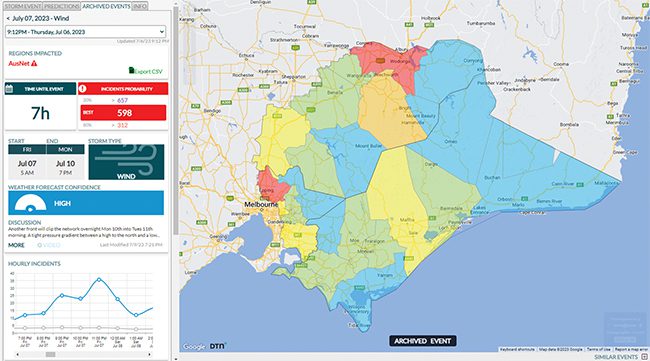AusNet Embraces Data-Driven Storm Impact Modeling
Power companies must respond to outages caused by extreme weather events. Having accurate predictions concerning the severity of impending storms can ensure companies are prepared with the right resources on standby ready to respond and helps them communicate restoration timelines accurately with customers.
Australian utility companies have had more than their fair share of weather challenges in recent years. From flooding, to searing heat, drought, and dangerous bushfire conditions, extreme weather has caused utility leaders and emergency operations teams to actively seek better intelligence to improve preparations for severe weather impacts.
For Australian energy company AusNet, the back-to-back disasters of the 2019–2020 bushfires, known as the Black Summer, and the June 2021 flooding were the catalyst for change. The utility serves more than 1.5 million customers through its three regulated networks: electricity distribution, gas distribution, and statewide electricity transmission network in Victoria. AusNet assets, staff, and customers were significantly affected by these incidents. Seeking to improve both planning and response, AusNet initiated a more proactive approach to uncovering insights from the decision data being used.
“We needed to move beyond simply looking at a weather forecast to more accurately anticipate the impact of severe weather events on our customers and operations,” said Sally Jacobs, emergency operations specialist at AusNet (Figure 1).
 |
|
1. Sally Jacobs, emergency operations specialist at AusNet, consults with an incident commander in the AusNet command center. Courtesy: DTN |
Utilities worldwide are actively reviewing their analytics needs and organizing data to improve decision-making. The recent Future of Utilities Summit in the UK included an entire track on network digitalization. Data in the utilities industry offers insight into important metrics related to power generation and delivery. But gathering data is just the start. The critical piece is how utilities model and manage the insights from the data to improve their efficiency and bottom line.
According to Nic Wilson, DTN product manager for Weather Risk, utilities in Australia are echoing what is happening in nearly every part of the world. DTN is a data analytics and technology company that helps utilities to mitigate, plan, and prepare for all types of weather impact. The company reports a significant increase in requests for new, data-driven weather risk and outage response technology across the globe.
“The universal remit for utilities is to deliver safe and reliable service to their customers, and when the power does go off, they want to respond as quickly and safely as possible,” explained Wilson. “They see that environmental conditions have shifted, and we hear from them that what once worked for rapid response is no longer a sustainable option.”
Since 2000, the U.S. has experienced a 78% increase in major power outages from weather-related events, according to Climate Central. Extreme weather, such as high temperatures, has also impacted Australia’s power supply in the past. Wilson noted that compound weather and climate events, such as the Australian bushfires followed by extreme flooding, will further challenge utilities to plan for multiple outage scenarios simultaneously.
Using Artificial Intelligence for Real-Time Decisions
Like many utility companies, AusNet previously relied on disconnected data and historical recollection to anticipate the potential for and severity of outages in specific service areas. The various sources of information created ambiguity in response strategies and made it challenging to deploy the appropriate level of resources.
“We’d err on the side of caution and get all hands on deck only to find the predicted storm didn’t impact our network,” offered Alanna Pollock, manager of Reliability and Network Performance at AusNet. “In the ideal world, we wanted to lean on our experiences from similar events but couldn’t translate our previous work effectively.”
This approach is not uncommon for utilities, Wilson noted. “They deal with the data they can tap into in the moment. But the power comes from blending and modeling it based on industry and service-area specific factors. That is how they get the operational intelligence needed to best plan and make decisions in real-time.”
The most advanced tool for helping energy companies plan and respond to outages uses artificial intelligence (AI). Advanced modeling shortens the time between data collection, analysis, and action. It also provides actionable insights expected to provide the best outcomes overall. Machine learning, a subset of AI, automatically learns from historical data and adapts to new intel by absorbing massive amounts of unstructured data. The information is then organized and integrated with other relevant data streams to deliver a more informed, and up-to-date analysis of the dynamic environment.
“That is why we ultimately chose DTN Storm Impact Analytics,” Pollock said. “The combination of a solution that uses the most advanced modeling, and is built upon historical weather and outage data specific to our infrastructure and service areas helps us balance outage response.”
In addition to historical and real-time data, Storm Impact Analytics (Figure 2) delivers sophisticated, hyper-local weather data blended with other diverse sets of information relevant to utilities, including grid performance, infrastructure integrity, service areas, topography, and vegetation management. Weather forecasts are continually updated every six hours using the latest DTN global weather forecast in a high-performing cloud platform collapsing the time between data collection and decision.
 |
|
2. DTN Storm Impact Analytics outage prediction forecast for a July wind event across the AusNet service territory by crew planning area. Courtesy: DTN |
“It’s nice as a business to have a single source of truth on which we all agree and trust,” Jacobs said. “This centralized, real-time tool has become a trusted resource for us to reliably mobilize our operational resources. Post-incident reviews have shown that it is helping the operations teamwork more efficiently.”
Innovative Technology Fills Many Different Stakeholder Demands
Like many utility service areas, Victoria’s diverse topography—mountains, grasslands, forest, and beaches—makes it difficult to have a standard response protocol. During winter months, the region is prone to intense winds, heavy rain, and storms, while summer weather swings in the opposite direction, often resulting in heat waves and bushfires. Adding to the response challenges are the dense forests in eastern Victoria, making it difficult to restore power quickly to all affected areas, particularly in remote or hard-to-reach regions. AusNet now has improved, consistent line of sight to all its assets and service areas, and the ability to quickly pull information about specific parts of its grid and potential risk scenarios.
The hyperlocal nature of the DTN weather data improves the ability of the AusNet control room, field, customer, and media teams to monitor potential network impact, and interpret alerts and forecasts into actionable responses for their specific needs. For certain weather risks, especially wind, which is the most problematic weather type for AusNet, Storm Impact Analysis (SIA) continues to be the primary source of mobilization. The team also uses it to categorize the severity of weather events, which allows them to coordinate resources across the control room and field for outage response priority. The shared data also provides improved decisioning and context for customer communications and alerts in support of the AusNet mission to create a seamless customer experience, build trust, and do what is right for local communities.
DTN’s Wilson pointed out a recent utility survey that showed utilities that installed technology to help with severe weather prediction and response reported a 39% increase in customer satisfaction and had positive media coverage. With better intelligence around severe weather threats, energy companies see fewer instances where field crews, control rooms, and customer response teams are either over or under deployed, and managers are more confident in allocating resources in anticipation of the network impacts.
“The main way we use the SIA data is to manage our response teams effectively,” Pollock explained. “But the information and the learnings from historical data are also helpful in calculating the estimated restoration time for our customers, so we can have a higher degree of certainty in sharing those messages with them.” She noted the combination of effective outage management and customer communication easily fulfills regulatory obligations.
Future Impacts of Extreme Weather
Consistent with the growth of extreme weather across the globe, Australia has warmed, on average, by almost 1.5C since record-keeping began in 1910, with most of that change happening in the past 25 years. “Australia has transitioned from record-breaking heat, drought, and bushfires to unprecedented rain and flooding in recent years, fueled by three back-to-back La Niña events,” explained Weatherzone Meteorologist Ben Domensino. Flooding can impact utility response and crew access to flooded regions. Also, heavy rain soaks the soil, which can result in more downed trees during high winds, leading to more incidents.
Domensino warned the return to El Niño in 2023 threatens to see a return of warmer and drier weather, with an increased risk of intense heatwaves and bushfires. “El Niño typically causes below average rainfall and above average daytime temperatures over large areas of Australia, including Victoria,” said Domensino, “which raises the risk of drought, extreme heatwaves, and bushfires.”
Whether it is rain, drought, wildfires or extreme temperatures, the scientific consensus is that the frequency and intensity of extreme weather events are on the rise. That also means the potential for more damage to infrastructure and disruption to services. Jacobs said Ausnet has already taken proactive measures to better prepare for the weather impacts of today, as well as the unforeseen impacts of climate change in the future by scenario-planning with Storm Risk Analytics datasets.
“We are always seeking innovative solutions to help ensure reliable power for our customers,” Pollock said. “Making data-driven decisions using AI and advanced modeling built upon AusNet’s infrastructure and service areas strengthens our risk management strategy and transforms how we respond to weather events in the future.”
—Renny Vandewege is vice president of Global Commercial at DTN.